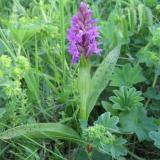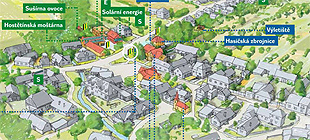
Reed-bed Sewage Treatment Plant
Reed-bed treatment systems (RTBS) are man-made wetlands with planted common wetland species and horizontal subsurface sewage water flow. They function through natural self-purifying processes in the soil environment saturated with water. When sewage water flows through filter medium, impurities are released due to a combined effect of physical, chemical and biological processes.
The self-purification process that takes place in reed-bed treatment systems, is based on the ability of bacteria to degrade organic impurities with their enzymes. This process is used also in vegetated treatment systems where bacteria create macrophyte on roots and a biologically active membrane on filter medium.
Advantages of natural treatment
They include an ecological nature of the facility, possibility of sensitive incorporation in the environment, relatively simple technological and construction design, possibility of sudden high impact, a short-term and long term interruption of the operation, good treatment effects even of diluted sewage water, partial binding of nitrogen and phosphorus as well as heavy metals, possibility to treat sewage water with high proportion of ballast water with low content of organic matter, economic effects consisting in an improvement of soil fertility and increased harvest yield with irrigation. Advantages of reed-bed sewage treatment plants versus traditional sewage treatment plants include low operating costs, simple but regular service, ability to absorb sewage water with considerable fluctuation in composition and amount. On the contrary, a drop in efficiency, often discussed, is not pronounced in winter.
Drawbacks of vegetated treatment
The drawbacks include relatively high requirements of area, a certain dependence of purification effects on climatic conditions, primarily on temperature and solar radiation, necessity of regular qualified attendance which is simple, though, quite a long delay due to a necessity to remove ammonia pollution.
Reed-bed Sewage Treatment Plant in Hostětín
It has been continuously operating since July 1997 as the first sewage treatment plant of this kind in the White Carpathians as well is in eastern Moravia. The construction of this sewage plant allowed to do away with a long-lasting building ban (protection zone of water-supply reservoir Kolelač) and opened possibilities of the village development.
The operation of the sewage plant has been permanently monitored. It has become a local biocentre with educational functions. It was the first sign for the Hostětín citizens and for the whole region signalling that an environment-friendly and autonomous solution of necessary municipal infrastructure may establish a brand new direction in considering the future of the countryside.
Investment and operating costs
A total investment amounting to CZK 4 905, 000 (waste water disposal system and RBTS) was shared by the following institutions:
Uherské Hradiště District Council (CZK 4 500, 000)
Ministry of Environment of the Czech Republic, the program River System Revitalization (CZK 320, 000 for pond construction).
The technology based on natural processes requires regular but undemanding maintenance and low running costs compared to standard technologies.
More from the history
In 1966 the water reservoir of Bojkovice was built by the municipality, bellow Hostětín, on the Kolač stream running through. Hostětín is the only village located in the catchment area of the reservoir, and in compliance with the standards on water resources protection a building blockage had been declared in the village before the reservoir was finished. 1990 the village became independent. The main task of a new local board was to build a sewage treatment plant, and thus remove the building blockage which excluded further development of the village.
In May 1993, in the upper Olšava catchment area, ZO ČSOP Veronica arranged a seminar focused on water purity, intended for local authority staff. Participating specialists, mayors and district officials agreed upon that a reed-bed sewage treatment plant is the best solution for Hostětín. In July 1995 a construction of the reed-bed sewage treatment plant was launched, and in July 1997, the plant was put into permanent operation.



 Show a map of all projects »
Show a map of all projects »



